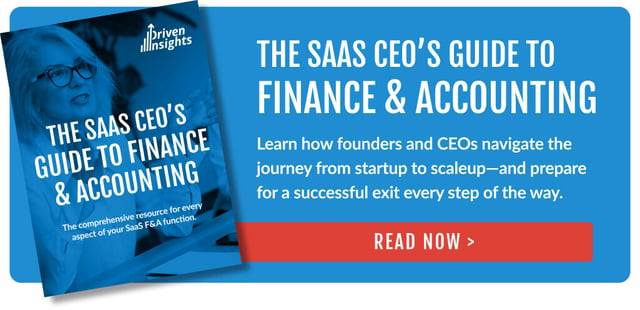
For a SaaS business, knowing exactly when and how much to invest in growth is critical to success. Overspending in areas like sales and marketing will cause a SaaS firm to burn through cash too quickly. While it’s tempting to pile on sales reps in the spirit of growth, investing heavily in acquiring new customers before you have product/market fit and a repeatable, profitable sales process will likely waste precious cash. On the other hand, once both are in place, your mindset must shift because at that stage underspending could be equally problematic if you’re looking to maximize enterprise value.
Enter customer acquisition cost (CAC)—the SaaS metric that reveals how much a firm spends on average to acquire a new customer and, importantly, whether it should be spending more (or less) to fuel efficient growth.
A key performance indicator for founders, CEOs, board members, and investors alike, CAC is a simple concept with a straightforward formula. Unfortunately, enough SaaS companies still miscalculate, misunderstand, and misuse CAC that it is considered one of the top reasons for SaaS failure. Indeed, getting CAC wrong can have far reaching implications.
So, how can you calculate CAC accurately and consistently?
When is the right time to calculate CAC?
What costs should CAC include?
What key insights does CAC provide?
In this article, we’ll answer these questions and more, so you can calculate CAC accurately and consistently, avoid common mistakes, and make informed decisions when investing in growth.
What is Customer Acquisition Cost?
Customer Acquisition Cost (CAC) is the amount a business spends on average to acquire a new customer. CAC typically accounts for sales and marketing costs, but there are no defined standards for what is—or isn’t—included in the calculation, so inconsistent calculations are common across the industry and even within a single firm.
CAC is a key SaaS metric that informs important decisions throughout businesses with a subscription-based model. Sales can use CAC to gauge the efficiency of its team, tools, and process. Marketing can use CAC to identify the most effective channels and tactics. Finance can use CAC to inform budgeting decisions. Management and the board can use CAC to determine how and when to deploy capital, as well as crafting the financial story to raise capital and determine when additional capital will be required.
When used properly, CAC plays a central role in strategic and operational decisions that align every department within a SaaS organization on the common goal of efficient growth. When misunderstood and misused, however, it can quickly lead to a false view of company health that leads to widespread problems.
New CAC vs Blended CAC
New CAC and Blended CAC are two different ways to look at customer acquisition costs. It’s extremely important for all stakeholders in a SaaS business to understand which is being referenced at any point in time, as misunderstandings are commonplace and the resulting confusion can distort other metrics and skew important decisions.
New CAC refers to sales and marketing costs incurred in the acquisition of a new customer.
Blended CAC factors in upsell, expansion and renewal efforts—costs associated with getting existing customers to renew, buy more, or expand their subscriptions.
In this article, we’ll focus on New CAC.
Why CAC is the Most Important Sales Efficiency Metric
CAC is the foundational metric for sales efficiency, which drives critical decisions as a SaaS firm readies itself to scale. Sales efficiency refers to how much revenue is generated for every dollar spent on sales and marketing. SaaS companies rely on sales efficiency metrics to determine how much to invest in sales and marketing, and what level of return to expect.
SaaS Magic Number and other sales efficiency metrics are important, but it all starts with CAC. When CAC is inaccurate, other metrics are flawed, critical decisions are being made in the dark, and a SaaS firm can waste millions.
SaaS CAC and Unit Economics
CAC is also at the core of a SaaS firm’s unit economics. That means quantifying not just how much it costs to acquire a single customer, but also how long it takes to recoup those costs (CAC Payback) and how long that customer will stay (Lifetime Value, or LTV). Metrics like LTV:CAC ratio and CAC Payback are essential to understanding the profitability of a SaaS business—and play an important role in valuation.
CAC as a Cash Flow Tool
CAC is an essential tool for cash management at every stage of SaaS growth. An accurate gauge of customer acquisition cost is vital to managing cash burn and runway in the early stages. Here, a SaaS company must rely on CAC to show how long it can survive on its current path.
In the later stages, this sales efficiency metric lets a SaaS firm know when to step on the gas and invest heavily in sales and marketing. CAC also plays a key role in cash flow forecasts, allowing companies to estimate their future cash flow needs as they plan for rapid expansion.
How to Calculate SaaS Customer Acquisition Costs
The basic formula for calculating New CAC is:

While the formula for CAC may appear simple, its components represent a significant degree of nuance. Do sales and marketing expenses only account for new customer acquisition? How do you separate this from Blended CAC? Exactly what sales and marketing expenses should you include?
Let’s examine the many ways CAC can lead to confusion in SaaS companies.
Common Mistakes when Calculating or Using CAC
Getting CAC wrong can have far-reaching implications, as seasoned SaaS entrepreneur and investor, David Skok, explains:
“It doesn’t take a genius to understand that business model failure comes when CAC (the cost to acquire customers) exceeds LTV (the ability to monetize those customers … A well-balanced business model requires that CAC is significantly less than LTV.”
The concept is elementary, yet SaaS companies continue to make costly CAC mistakes that contribute to slow growth, devaluation, and business failure. Let’s take a look at the most common mistakes to avoid.
Obsessing Over CAC too Early
A SaaS business should take care not to overthink CAC in the early stages. When the priorities are product/market fit and building a repeatable sales process, customer acquisition costs will typically be higher compared to more established companies. CAC will also fluctuate as a consistent sales process has yet to be implemented.
Confusing New and Blended Customer Acquisition Costs
While New CAC measures the cost of acquiring a new customer, Blended CAC factors in the costs of maintaining and growing existing customer relationships. As you’re scaling through a major investment in sales and marketing, timing is everything—and you’ll want a clear focus on New CAC.
Blended CAC is helpful down the line, but you must have the systems required to accurately segment costs between new customer acquisition and customer expansion. Most importantly, stakeholders must always understand which form of CAC is being used, so everyone is on the same page when decisions are being made.
Accounting for Founder or CEO Involvement in CAC
SaaS founders and CEOs are typically contributing to sales in the early stages. If their salary isn’t included in the calculation, CAC will be artificially low. This might lead a firm to think their CAC payback is better than it really is, painting an inaccurate picture of sales efficiency and company health. Factoring founder or CEO salaries into the CAC equation, however, gets tricky. Even if prorated, the addition will likely overburden the CAC figure, as those salaries won’t be comparable to a sales rep’s compensation.
Timing CAC Calculations Accurately
Avoid using the sales booking date as the basis for CAC calculation. Instead, base your CAC calculations on the subscription start date, to ensure you’re accurately reflecting costs over a specific period.
Only Accounting for Paying Customers
It might be tempting to include trial or freemium customers in a CAC calculation, but unpaid users will throw off your numbers. Only include paying customers when calculating customer acquisition cost.
Everyone in Your SaaS Company Must Understand and Align on CAC
CAC is a key SaaS metric that will drive critical decisions, and accuracy and consistency is paramount. While everyone in your organization might agree on the importance of understanding how much it costs to acquire a customer, there’s still a lot of room for interpretation. It’s far too easy to miscalculate, misuse, or miscommunicate CAC across multiple departments and stakeholders.
Here’s how to get your entire organization on the same page:
- Agree on a company-wide definition and calculation of CAC.
- Align on New CAC vs. Blended CAC so everyone is speaking the same language.
- Ensure everyone knows what’s included in the calculations.
- Measure accurately and consistently over time periods.
- Segment CAC in ways that drive action: By product, channel, country, cohort, campaign, or other methods.
- Choose only benchmarks that you can confirm are calculated the same way as your firm’s CAC
Related Content: Choosing the Right Subscription Management Platform
You need the right subscription billing tool to properly measure and analyze SaaS KPIs. Explore 9 things to look for in your search.
The more your leadership team, board, management, and other stakeholders are aligned on key SaaS metrics like CAC, the more informed decisions will be at every level. Establishing this organizational understanding and alignment is one the primary roles of a SaaS CFO, and is essential for firms at every stage of growth.
CFO-level finance leadership isn’t just for growth stage SaaS companies. Neither is a complete SaaS finance and accounting team, and the systems and technology it brings to the table.
Learn how your firm can integrate all the finance resources it needs with an outsourced CFO service for SaaS businesses. Schedule your introduction to Driven Insights today, get a free proposal, and discover a flexible solution designed to accelerate growth and scale with your needs.








